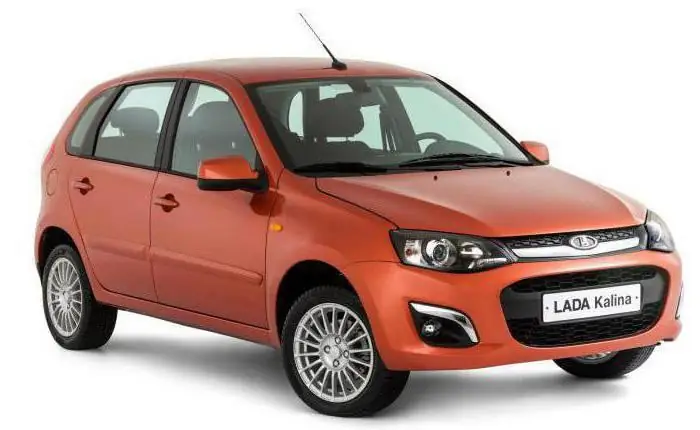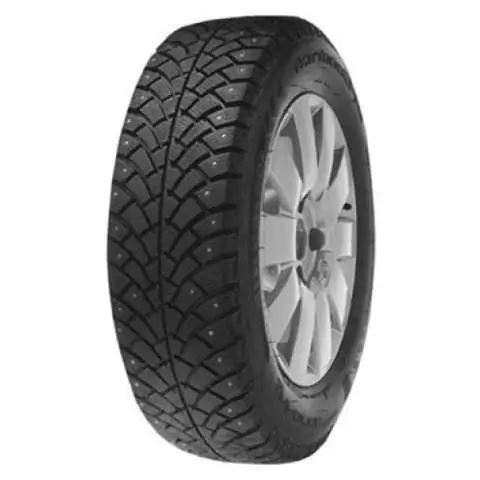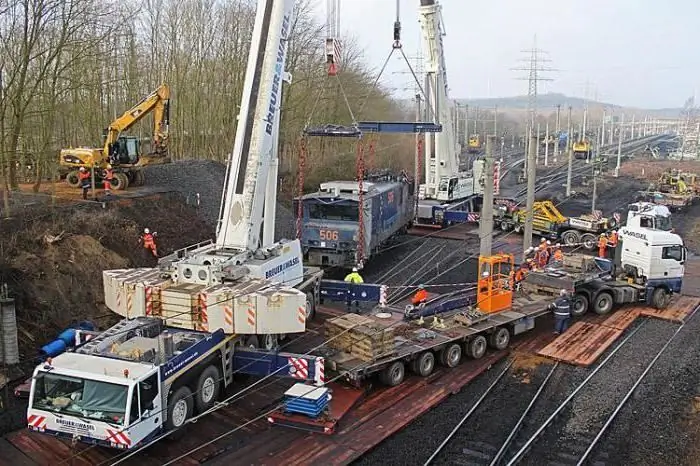2025 Author: Erin Ralphs | [email protected]. Last modified: 2025-01-22 21:14:11
Air transportation in our time is gaining more and more popularity not only when moving passengers, but also when transporting various goods over any distance. But, despite this, the railway does not lose its relevance due to its cheaper cost. Here, as in road transport, emergencies can also occur with different consequences. And then such a unit as a recovery train comes into operation. Read below about what it is.
What are recovery trains?
The transport unit, called the recovery train, is a special formation whose main duty is to eliminate the consequences of emergencies that occurred on the railway tracks. These may be cases of rolling stock derailment or collision of locomotives.

In addition, the recovery train team, within its technical capabilities, canprovide first aid to victims of accidents or natural disasters.
Important role
The main task facing the rolling stock brigade is to ensure the speedy resumption of railway traffic. Involving the recovery train in the work, it is necessary to manage with minimal losses of material values. And in the presence of victims, the safety of life and he alth of people always comes first.
Equipment
For the necessary work, the rolling stock has all the necessary equipment and tools. On board the train there is a crane and various devices for lifting bulky goods, there are hydraulic jacks. The recovery unit also includes tractors equipped with winches, tractors, bulldozers.
In order to supply electricity to the train, power plants are provided. If it is necessary to carry out work in the dark, searchlight installations are provided.
In addition, depending on the specific situation, the recovery train may have on board different cars, equipment for welding and metal cutting. The train can also be successfully used to extinguish fires with the appropriate equipment.

The entire train has several dozen cars, each of which has its own purpose. The pantry car provides storage of the necessary material and tools. In addition, the composition consists of:
- car withcatering department;
- ambulance car;
- working platform.
The train must always be in good technical condition in order to immediately leave on the first call. In order to ensure efficiency, the composition has means of communication.
Organization of the recovery process
The volume of all restoration work and the time of their implementation depend on the number of transport units in an emergency. When a recovery train is called to the scene, they also take into account the degree of damage to the trains, whether there is cargo on board, whether the accident affected the technical condition of the railway track, and a number of other factors.

The situation can be noticeably more complicated if the accident occurs in a tunnel or on a bridge, especially if there is significant damage. The danger is represented by cases of accidents of trains that transported dangerous or flammable goods. No less dangerous is a train derailment near a populated area.
Each emergency situation is unique in nature, and there are no, for example, completely identical cases of train derailment when a recovery train is called. Work in this case is carried out in accordance with the developed general tactics of the recovery process, which involves several stages:
- gathering incident information;
- delivery of the transport unit to the accident site;
- carrying out restoration work.
It is extremely important that each ofstages took as little time as possible, especially when it comes to victims.
Information gathering
The main task that the Russian Railways recovery train must solve is to quickly collect all the necessary information about the incident, during which it is necessary to determine the nature of the accident (collision, derailment). It is also important to find out if there are casu alties, the presence of dangerous goods and the possibility of fire. This also takes into account the area where the accident occurred, the condition of the railway track and trains.

The most complete information will allow you to make the right decision about the number of recovery units that will need to be sent, the availability of equipment and the necessary materials. Omission of even the smallest detail at first glance and delay threatens with great losses. And human life is priceless.
Delivery of composition
When information is received about any incident, immediate action is taken. Depending on the situation, recovery and fire trains may be sent, or additional forces may be involved: units of the Ministry of Internal Affairs, Civil Defense, as well as other necessary services. Responsibility for deciding on the number of recovery trains sent lies with the head of the railway department. If a large amount of work is foreseen, then the responsibility passes to the head of the road.
As for the departure time of trains, during working hours it is no more than 30 minutes, and at other times - up to 40 minutes. Whereinthe movement of any recovery and fire locomotive has priority over all other types of rail transport.

Restoration work
After collecting all the necessary information, one repair train or several trains are sent to the scene. To correct the situation associated with the derailment of the train, the optimal solution for its rise is selected.
Descent of almost the entire composition is almost always accompanied by damage to the railway. In this regard, high demands are placed on the recovery process. Right before the work, a special group of people collect materials that will help shed light on the cause of the accident.
The entire recovery procedure is carried out according to the standard scheme. First of all, the damaged train and cargo are removed from the tracks. In order to avoid the loss of expensive cargo, a procedure for its protection and cleaning is organized. In the future, the emergency recovery train is used if it is necessary to repair the rails. At the same time, it is carried out not after the complete cleaning of the train, but as the tracks are cleared of the cars.

A little digression into history
People who follow the correction of the consequences of accidents on the railway tracks, is dedicated to a professional day, the celebration of which falls on November 11th. History mentions the first appearance of a recovery train in 1936. All thanks to L. M. Kaganovich,who signed the order, which mentioned the reconfiguration of the operating mode of the recovery train. At that time, it was impossible to do quality work on auxiliary trains. Therefore, on their basis, recovery trains of Russian Railways were created, which should ensure not only high quality work, but also maximum efficiency.

In other words, the entire structure of recovery trains has existed practically since the development of the railway network in Russia. The equipment was heavy at first, and had to work in the most difficult conditions. As for the uniform of the workers, it was simple and not very comfortable. Nevertheless, people did their job.
Currently, modern technology is used, but despite this, the quality of work directly depends on the qualifications of the staff. Employees regularly undergo training to continuously improve their skills.
Recommended:
Battery recovery. Salvation or Torment?

The beginning of the 21st century amazes everyone with its discoveries and ambitious plans. Progress does not stand still, covering all large areas. Since the creation of the battery, it has undergone many changes, but to this day it is the leader among non-stationary sources
Car battery, desulfation: recovery methods

The article describes how to restore the battery at home. Do-it-yourself battery desulfation in several ways
Russian cars: cars, trucks, special purposes. Russian auto industry

The development of the Russian car industry, which in Soviet times became famous thanks to the following cars: Moskvich and Zhiguli, began in the 19th century. Before the emergence of the Union of Republics, the industry got up on its feet several times and immediately fell, and only by 1960 it began to live to the fullest - mass motorization was launched. From the crisis that followed immediately after the collapse of the USSR, with difficulty, but the Russian auto industry got out
Russian tires: characteristics, review. Russian tire manufacturers

Russian tyres: Moscow Tire Plant, OAO Nizhnekamskshina, Yaroslavl tyres. Characteristics, description. Tires for SUVs and passenger cars. Reviews, photo
Russian Mechanics ATVs: vehicles for real Russian off-road

In our review, we will consider the most popular creations of this manufacturer, designed for real Russian off-road

